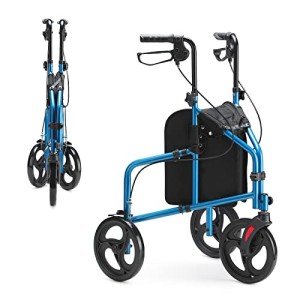How To Determine If You're Ready For Seat Walker
페이지 정보

본문
The Seat Walker: A Comprehensive Guide to Mobility Aids
When it pertains to maintaining independence and mobility, people with limited mobility or impairments frequently depend on numerous assistive gadgets. One such gadget that increasingly concerns the leading edge of mobility aids is the seat walker. This article provides a thorough look at seat walkers-- their functions, benefits, types, and the aspects to consider when picking one.
What is a Seat Walker?
A seat walker is a flexible mobility aid designed primarily for people who might have trouble walking unaided. It typically features a frame with wheels, manages for support, and an integrated bench or seat, permitting users to take breaks when required. Unlike standard walkers or rollators, which just provide support for walking, the addition of a seat makes the seat walker substantially more practical for many users.
Secret Features of Seat Walkers
- Wheels: Most seat walkers are equipped with front wheels that enhance mobility and ease of use, enabling users to move efficiently over various surface areas.
- Seat or Bench: The most distinguishing feature is the integrated seat, which provides a resting place for users when tiredness sets in.
- Deals with: Adjustable handles deal with various user heights, offering sufficient assistance and guaranteeing a comfortable grip.
- Brakes: Safety brakes avoid the walker from rolling away when somebody is seated, improving user security.
- Lightweight Frame: Many models are created to be lightweight, making them simpler to carry and maneuver.
Benefits of Using a Seat Walker
Seat walkers have many benefits that make them a perfect option for numerous users.
- Boosted Mobility: They provide higher stability and support than conventional walkers, reducing the threat of falls.
- Convenience: The capability to rest at any point makes them suitable for those who tire easily or have limited stamina.
- Independence: Seat walkers permit users to preserve a degree of independence by allowing them to stroll and rest without support.
- Adaptability: Suitable for both indoor and outdoor use, these walkers can adapt to different environments.
- Physical Activity: Regular use encourages physical activity and social interaction, which can enhance general wellness.
Kinds Of Seat Walkers
Various types of seat walkers deal with the varying requirements of users. Here is a breakdown of the most common types:

| Type | Features | Best For |
|---|---|---|
| Standard Seat Walker | Basic style, frequently with a lightweight frame and minimal functions. | Users requiring basic mobility assistance. |
| Durable Seat Walker | Enhanced frame, greater weight capability, often with larger seats. | People needing more robust support. |
| Rollator With Seat (182.92.251.55) | Combines seats with multi-height adjustable handles and better maneuverability. | Users requiring frequent resting alternatives. |
| Transport Seat Walker | Designed for easy transport; often folds and has a little footprint. | Active users who travel frequently. |
Selecting the Right Seat Walker
Selecting a seat walker involves numerous factors to consider to guarantee it satisfies the user's particular needs. Here are important elements to remember:

- Weight Capacity: Ensure that the seat walker can support the user's weight conveniently.
- Seat Height: Check the height of the seat to guarantee it is suitable and comfortable for the user.
- Width: Consider your living area and make sure the walker can fit through doors and narrow passages.
- Wheel Size: Larger wheels can handle rougher surface, while smaller wheels are much better suited for indoor use.
- Weight of the Walker: A lightweight walker is helpful for simple maneuverability and transportation.
- Brakes and Safety Features: Look for dependable brakes and safety assurances, such as stability and anti-tip features.
Setting a Budget
Seat walkers vary significantly in price depending on their features and build quality. While it's important to find a model that fulfills the user's needs, it's similarly crucial to set a sensible spending plan.
Average Price Ranges:
- Basic Models: ₤ 50 to ₤ 150
- Rollators with Added Features: ₤ 150 to ₤ 300
- Durable Models: ₤ 300 and up
FAQs About Seat Walkers
Q1: Who ought to use a seat walker?A1: Seat walkers are perfect for individuals with minimal mobility due to age, injury, or chronic conditions who need extra assistance while walking. Q2: Are seat walkers safe?A2: Yes, seat walkers are developed with safety in mind. They generally include brakes, sturdy frames, and slip-resistant grips. Q3: How do I keep my seat walker?A3: Regularly check the brakes and wheels for wear and tear.
Tidy the frame with a moist cloth and ensure
screws and elements are tight. Q4: Can seat walkers be used outdoors?A4: Yes, lots of seat walkers are designed for both indoor and outdoor use, though designs with larger wheels carry out much better on irregular surface areas. Q5: How do I understand
which seat walker is best for me?A5: Consult with a healthcare provider or physical therapist who can examine your mobility needs and advise suitable choices based on your special situation. The convenience and flexibility of seat walkers make them an indispensable tool for those with mobility difficulties. By providing support, stability, and a chance for rest, they empower users to remain active and independent. When choosing a seat walker, people must consider their individual needs, lifestyle, and safety to discover the best match for them. With the best seat walker, lots of users can enjoy a renewed sense of freedom, improving their quality of life and maintaining their self-reliance. In summary, whether one is browsing through the home, running errands, or enjoying fresh air in a park, a seat walker can show to be a vital companion, transforming daily activities into manageable jobs.
- 이전글The Reason Why Walking Machine Has Become The Obsession Of Everyone In 2024 25.06.10
- 다음글10 Things That Your Family Taught You About Robot Hoover Uk 25.06.10
댓글목록
등록된 댓글이 없습니다.